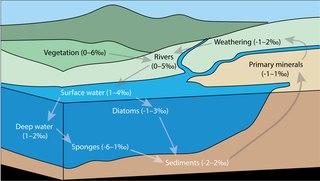Related Research Articles

Apatite is a group of phosphate minerals, usually hydroxyapatite, fluorapatite and chlorapatite, with high concentrations of OH−, F− and Cl− ion, respectively, in the crystal. The formula of the admixture of the three most common endmembers is written as Ca10(PO4)6(OH,F,Cl)2, and the crystal unit cell formulae of the individual minerals are written as Ca10(PO4)6(OH)2, Ca10(PO4)6F2 and Ca10(PO4)6Cl2.

Magnesite is a mineral with the chemical formula MgCO
3. Iron, manganese, cobalt, and nickel may occur as admixtures, but only in small amounts.

A micrometeorite is a micrometeoroid that has survived entry through the Earth's atmosphere. Usually found on Earth's surface, micrometeorites differ from meteorites in that they are smaller in size, more abundant, and different in composition. The IAU officially defines meteorites as 30 micrometers to 1 meter; micrometeorites are the small end of the range (~submillimeter). They are a subset of cosmic dust, which also includes the smaller interplanetary dust particles (IDPs).

The Lunar Magma Ocean (LMO) is the layer of molten rock that is theorized to have been present on the surface of the Moon. The Lunar Magma Ocean was likely present on the Moon from the time of the Moon's formation to tens or hundreds of millions of years after that time. It is a thermodynamic consequence of the Moon's relatively rapid formation in the aftermath of a giant impact between the proto-Earth and another planetary body. As the Moon accreted from the debris from the giant impact, gravitational potential energy was converted to thermal energy. Due to the rapid accretion of the Moon, thermal energy was trapped since it did not have sufficient time to thermally radiate away energy through the lunar surface. The subsequent thermochemical evolution of the Lunar Magma Ocean explains the Moon's largely anorthositic crust, europium anomaly, and KREEP material.

Isorenieratene /ˌaɪsoʊrəˈnɪərətiːn/ is a carotenoid light harvesting pigment produced exclusively by the genus Chlorobium. Chlorobium are the brown-colored strains of the family of green sulfur bacteria (Chlorobiaceae). Green sulfur bacteria are anaerobic photoautotrophic organisms meaning they perform photosynthesis in the absence of oxygen using hydrogen sulfide in the following reaction:

Timothy Ian Eglinton is a professor of biogeoscience at the Geological Institute, ETH Zürich.
Robert Norman Clayton was a Canadian-American chemist and academic. He was the Enrico Fermi Distinguished Service Professor Emeritus of Chemistry at the University of Chicago. Clayton studied cosmochemistry and held a joint appointment in the university's geophysical sciences department. He was a member of the National Academy of Sciences and was named a fellow of several academic societies, including the Royal Society.
Carbonate-associated sulfates (CAS) are sulfate species found in association with carbonate minerals, either as inclusions, adsorbed phases, or in distorted sites within the carbonate mineral lattice. It is derived primarily from dissolved sulfate in the solution from which the carbonate precipitates. In the ocean, the source of this sulfate is a combination of riverine and atmospheric inputs, as well as the products of marine hydrothermal reactions and biomass remineralisation. CAS is a common component of most carbonate rocks, having concentrations in the parts per thousand within biogenic carbonates and parts per million within abiogenic carbonates. Through its abundance and sulfur isotope composition, it provides a valuable record of the global sulfur cycle across time and space.

Tetrahymanol is a gammacerane-type membrane lipid first found in the marine ciliate Tetrahymena pyriformis. It was later found in other ciliates, fungi, ferns, and bacteria. After being deposited in sediments that compress into sedimentary rocks over millions of years, tetrahymanol is dehydroxylated into gammacerane. Gammacerane has been interpreted as a proxy for ancient water column stratification.
Gas-rich meteorites are meteorites with high levels of primordial gases, such as helium, neon, argon, krypton, xenon and sometimes other elements. Though these gases are present "in virtually all meteorites," the Fayetteville meteorite has ~2,000,000 x10−8 ccSTP/g helium, or ~2% helium by volume equivalent. In comparison, background level is a few ppm.
Ruth E. Blake is an American geochemist and environmental scientist. She is a professor at Yale University in earth & planetary sciences, environmental studies, and chemical & environmental engineering. Blake's work focuses on marine biogeochemical processes, paleoclimate, astrobiology, and stable isotope geochemistry.
Sulfur isotope biogeochemistry is the study of the distribution of sulfur isotopes in biological and geological materials. In addition to its common isotope, 32S, sulfur has three rare stable isotopes: 34S, 36S, and 33S. The distribution of these isotopes in the environment is controlled by many biochemical and physical processes, including biological metabolisms, mineral formation processes, and atmospheric chemistry. Measuring the abundance of sulfur stable isotopes in natural materials, like bacterial cultures, minerals, or seawater, can reveal information about these processes both in the modern environment and over Earth history.
Cindy Lee is a retired Distinguished Professor known for her research characterizing the compounds that comprise marine organic matter.
Susan Humphris is a geologist known for her research on processes at mid-ocean ridges. She is an elected fellow of the American Geophysical Union.
Yan Zheng is a marine geochemist known for her research on metals in groundwater and private wells in Bangladesh, China, and the United States. She is an elected fellow of the Geological Society of America and the American Geophysical Union.
Hilairy Ellen Hartnett is professor at Arizona State University known for her work on biogeochemical processes in modern and paleo-environments.
Elizabeth A. Canuel is a chemical oceanographer known for her work on organic carbon cycling in aquatic environments. She is the Chancellor Professor of Marine Science at the College of William & Mary and is an elected fellow of the Geochemical Society and the European Association of Geochemistry.
Maureen Hatcher Conte is biogeochemist known for her work using particles to define the long-term cycling of chemical compounds in seawater.

Silicon isotope biogeochemistry is the study of environmental processes using the relative abundance of Si isotopes. As the relative abundance of Si stable isotopes varies among different natural materials, the differences in abundance can be used to trace the source of Si, and to study biological, geological, and chemical processes. The study of stable isotope biogeochemistry of Si aims to quantify the different Si fluxes in the global biogeochemical silicon cycle, to understand the role of biogenic silica within the global Si cycle, and to investigate the applications and limitations of the sedimentary Si record as an environmental and palaeoceanographic proxy.
Elisabeth Lynn Sikes is an American geoscientist who is a professor at Rutgers University. Her research considers carbon cycling. She was awarded the 2022 Scientific Committee on Antarctic Research Medal for Excellence in Research.
References
- ↑ "UC Santa Cruz - Peggy (Margaret) Delaney". people.ucsc.edu.
- ↑ Irwin, Elizabeth; Writer 459-2495, Guest. "Margaret L. Delaney appointed interim campus provost and executive vice chancellor at UC Santa Cruz". UC Santa Cruz News. Retrieved 2021-07-06.
- ↑ "Vice Chancellor Peggy Delaney retiring". UC Santa Cruz News. Retrieved 2021-07-02.
- ↑ "Paleoceanography and Paleoclimatology". AGU Journals. doi:10.1002/(ISSN)2572-4525 . Retrieved 2021-07-02.
- ↑ "Awards-Margaret Delaney named editor of Earth science journal". currents.ucsc.edu. October 31, 2005. Retrieved 2021-07-02.
- 1 2 3 Stephens, Tim (February 23, 2004). "UCSC ocean scientist Margaret Delaney elected fellow of the American Geophysical Union". UC Santa Cruz News. Retrieved 2021-07-02.
- ↑ Delaney, Margaret Lois; Bé, Allan W.H.; Boyle, Edward A. (1985-06-01). "Li, Sr, Mg, and Na in foraminiferal calcite shells from laboratory culture, sediment traps, and sediment cores". Geochimica et Cosmochimica Acta. 49 (6): 1327–1341. Bibcode:1985GeCoA..49.1327D. doi:10.1016/0016-7037(85)90284-4. ISSN 0016-7037.
- ↑ Linn, L.J; Delaney, M.L; Druffel, E.R.M (1990). "Trace metals in contemporary and seventeenth-century Galapagos coral: Records of seasonal and annual variations". Geochimica et Cosmochimica Acta. 54 (2): 387–394. Bibcode:1990GeCoA..54..387L. doi:10.1016/0016-7037(90)90327-H.
- ↑ Delaney, M.L; Linn, L.J; Druffel, E.R.M (1993). "Seasonal cycles of manganese and cadmium in coral from the Galapagos Islands". Geochimica et Cosmochimica Acta. 57 (2): 347–354. Bibcode:1993GeCoA..57..347D. doi:10.1016/0016-7037(93)90436-Z. S2CID 55665392.
- ↑ Filippelli, Gabriel M.; Delaney, Margaret Lois (1996-05-01). "Phosphorus geochemistry of equatorial Pacific sediments". Geochimica et Cosmochimica Acta. 60 (9): 1479–1495. Bibcode:1996GeCoA..60.1479F. doi:10.1016/0016-7037(96)00042-7. ISSN 0016-7037.
- ↑ Delaney, M. L. (1998). "Phosphorus accumulation in marine sediments and the oceanic phosphorus cycle". Global Biogeochemical Cycles. 12 (4): 563–572. Bibcode:1998GBioC..12..563D. doi: 10.1029/98GB02263 .
- ↑ Faul, Kristina L.; Paytan, Adina; Delaney, Margaret L. (2005). "Phosphorus distribution in sinking oceanic particulate matter". Marine Chemistry. 97 (3–4): 307–333. doi:10.1016/j.marchem.2005.04.002.
- ↑ Wara, M. W. (2005-07-29). "Permanent El Nino-Like Conditions During the Pliocene Warm Period". Science. 309 (5735): 758–761. Bibcode:2005Sci...309..758W. doi: 10.1126/science.1112596 . ISSN 0036-8075. PMID 15976271. S2CID 37042990.
- ↑ Zachos, J. C. (2003-11-28). "A Transient Rise in Tropical Sea Surface Temperature During the Paleocene-Eocene Thermal Maximum". Science. 302 (5650): 1551–1554. Bibcode:2003Sci...302.1551Z. doi: 10.1126/science.1090110 . ISSN 0036-8075. PMID 14576441. S2CID 6582869.
- ↑ Scher, Howie D.; Whittaker, Joanne M.; Williams, Simon E.; Latimer, Jennifer C.; Kordesch, Wendy E. C.; Delaney, Margaret L. (2015). "Onset of Antarctic Circumpolar Current 30 million years ago as Tasmanian Gateway aligned with westerlies". Nature. 523 (7562): 580–583. Bibcode:2015Natur.523..580S. doi:10.1038/nature14598. ISSN 1476-4687. PMID 26223626. S2CID 205244510.
- ↑ "Union Fellows | AGU". www.agu.org. Retrieved 2021-07-02.
- ↑ "tos-fellows-meet | The Oceanography Society". tos.org. Retrieved 2021-07-02.
- ↑ "Outstanding Educator Award" (PDF). 2020.